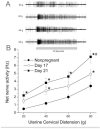Pregnancy increases excitability of mechanosensitive afferents innervating the uterine cervix
- PMID: 18497610
- PMCID: PMC3876482
- DOI: 10.1097/ALN.0b013e31817302e0
Pregnancy increases excitability of mechanosensitive afferents innervating the uterine cervix
Abstract
Background: Labor pain derives primarily from stimulation of afferents innervating the uterine cervix and lower uterine segment. The authors have previously shown that the excitability of these afferents is regulated by sex hormones and test in this study whether pregnancy also alters their excitability.
Methods: After animal care committee approval, Sprague-Dawley rats (nonpregnant, pregnant days 17 and 21) were anesthetized, and two metal rods were placed through the cervix for distension. The right hypogastric nerve was dissected and carefully teased until recording from a single unit was obtained. Spontaneous activity and the response to a graded distension (20-80 g) were recorded for off-line analysis.
Results: A total of 151 fiber units were recorded. Pregnancy was associated with an increase in spontaneous nerve activity in the absence of a mechanical stimulus (median of 0.98 and 1.56 Hz from pregnant days 17 and 21, respectively, compared with 0.45 Hz in nonpregnant; P < 0.01). The proportion of fibers responding to the weakest stimulus (20 g) was significantly greater in pregnant than in nonpregnant animals. The response to graded distension differed significantly among groups, with day 21 > day 17 > nonpregnant.
Conclusions: Afferents that innervate the uterine cervix sprout into this tissue during late pregnancy, and estrogen increases excitability of these mechanosensitive afferents. Here, the authors show that excitability also increases during pregnancy. These data suggest that, close to the onset of labor, there is an increased input to the spinal cord from cervical distension and an increased depolarization of afferent terminals in the cervix, effects that could influence pain and the progress of labor.
Figures





Similar articles
-
Chronic estrogen sensitizes a subset of mechanosensitive afferents innervating the uterine cervix.J Neurophysiol. 2005 Apr;93(4):2167-73. doi: 10.1152/jn.01012.2004. J Neurophysiol. 2005. PMID: 15774714
-
Functional differences between afferent fibers in the hypogastric and pelvic nerves innervating female reproductive organs in the rat.J Neurophysiol. 1993 Feb;69(2):533-44. doi: 10.1152/jn.1993.69.2.533. J Neurophysiol. 1993. PMID: 8459284
-
Analgesia is produced by uterocervical mechanostimulation in rats: roles of afferent nerves and implications for analgesia of pregnancy and parturition.Brain Res. 1991 Dec 6;566(1-2):299-302. doi: 10.1016/0006-8993(91)91713-b. Brain Res. 1991. PMID: 1814546
-
Changes in uterine innervation in pregnancy and during labour.Curr Opin Anaesthesiol. 2010 Jun;23(3):300-3. doi: 10.1097/ACO.0b013e328337c881. Curr Opin Anaesthesiol. 2010. PMID: 20216064 Review.
-
The role of sensory neurons in cervical ripening: effects of estrogen and neuropeptides.J Histochem Cytochem. 2004 Oct;52(10):1249-58. doi: 10.1177/002215540405201001. J Histochem Cytochem. 2004. PMID: 15385571 Review.
Cited by
-
Transection of the pelvic or vagus nerve forestalls ripening of the cervix and delays birth in rats.Biol Reprod. 2011 Mar;84(3):587-94. doi: 10.1095/biolreprod.110.086207. Epub 2010 Nov 24. Biol Reprod. 2011. PMID: 21106964 Free PMC article.
-
Resolution of pain after childbirth.Anesthesiology. 2013 Jan;118(1):143-51. doi: 10.1097/ALN.0b013e318278ccfd. Anesthesiology. 2013. PMID: 23249931 Free PMC article.
-
Spinal Cord Stimulation in Pregnant Patients: Current Perspectives of Indications, Complications, and Results in Pain Control: A Systematic Review.Asian J Neurosurg. 2019 Apr-Jun;14(2):343-355. doi: 10.4103/ajns.AJNS_7_18. Asian J Neurosurg. 2019. PMID: 31143246 Free PMC article. Review.
-
Sex differences and hormonal modulation of deep tissue pain.Front Neuroendocrinol. 2013 Oct;34(4):350-66. doi: 10.1016/j.yfrne.2013.07.002. Epub 2013 Jul 17. Front Neuroendocrinol. 2013. PMID: 23872333 Free PMC article. Review.
-
Oxytocin augmentation and neurotransmitters in prolonged delivery: An experimental appraisal.Eur J Obstet Gynecol Reprod Biol X. 2023 Dec 23;21:100273. doi: 10.1016/j.eurox.2023.100273. eCollection 2024 Mar. Eur J Obstet Gynecol Reprod Biol X. 2023. PMID: 38274243 Free PMC article.
References
-
- Rosenfeld SS. Paracervical anesthesia for the relief of labor pains. Am J Obstet Gynecol. 1945;50:527–32.
-
- Bonica JJ, Chadwick HS, Wall PD, Melzack R. Labour pain, Textbook of Pain. 2 edition Churchill Livingstone; New York: 1989. pp. 482–99.
-
- Berkley KJ, Hotta H, Robbins A, Sato Y. Functional properties of afferent fibers supplying reproductive and other pelvic organs in pelvic nerve of female rat. J Neurophysiol. 1990;63:256–72. - PubMed
-
- Tong CY, Ma WY, Shin SW, James RL, Eisenach JC. Uterine cervical distension induces cFos expression in deep dorsal horn neurons of the rat spinal cord. Anesthesiology. 2003;99:205–11. - PubMed
-
- Catheline G, Touquet B, Besson JM, Lombard MC. Parturition in the rat - A physiological pain model. Anesthesiology. 2006;104:1257–65. - PubMed

